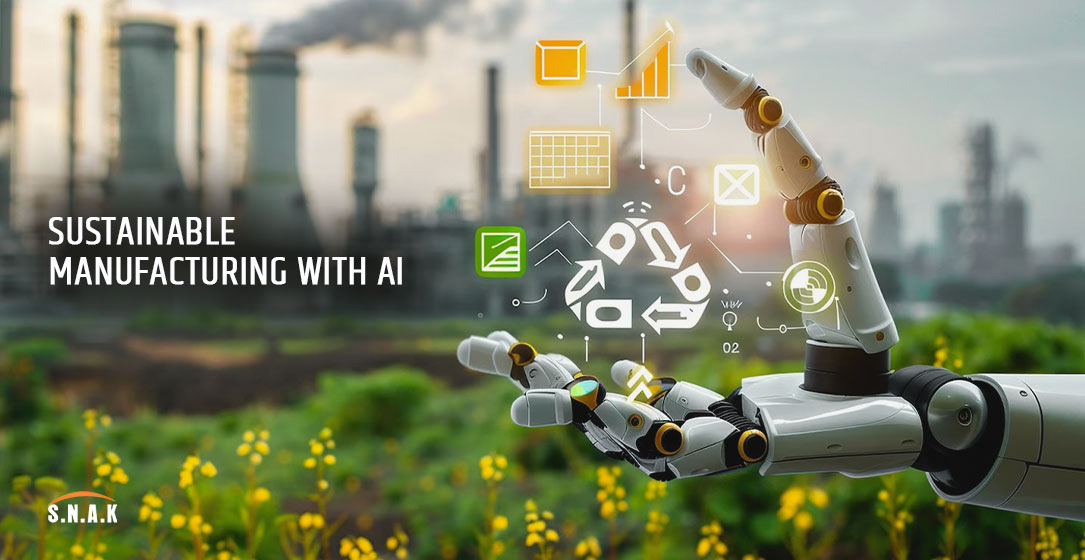October 7, 2025 | SNAK Consultancy
Share on :
Sustainable Manufacturing with AI: Reducing Waste and Energy Consumption

Introduction
In today’s competitive and environmentally conscious world, sustainability has become more than a buzzword—it’s a business imperative. The manufacturing sector, responsible for a significant share of global energy consumption and carbon emissions, is undergoing a transformation driven by Artificial Intelligence (AI) and Automation.
AI is enabling green manufacturing by optimizing production processes, minimizing waste, and significantly reducing energy usage. Let’s explore how AI-powered automation is helping manufacturers become more sustainable, efficient, and profitable—while achieving their ESG (Environmental, Social, and Governance) goals.
The Challenge of Sustainability in Manufacturing
Manufacturing industries consume nearly 54% of the world’s energy resources and generate massive waste—from production leftovers to inefficient energy use.
Traditional systems often rely on manual monitoring and reactive decision-making, making it hard to maintain efficiency or control emissions.
Key sustainability challenges include:
1. High energy consumption from outdated machinery
2. Excess material waste due to overproduction or inefficiencies
3. Carbon emissions from non-optimized logistics
4. Limited real-time visibility into production operations
AI and automation offer solutions that allow businesses to proactively manage these challenges with precision and data-driven intelligence.
The Role of AI in Sustainable Manufacturing
Artificial Intelligence introduces data-driven intelligence into every layer of manufacturing—from procurement to production to logistics. By analyzing large datasets in real time, AI helps identify inefficiencies, predict outcomes, and automate corrective actions.
Here’s how AI contributes to sustainability and cost savings:
1. Energy Optimization through Smart Monitoring
AI algorithms analyze machine-level energy usage data and predict optimal operational parameters.
1. AI-driven systems can automatically power down idle equipment.
2. Real-time monitoring helps identify energy-intensive operations.
3. Predictive analytics helps forecast peak energy usage and avoid unnecessary consumption.
For example, an AI-based energy management system on Microsoft Azure can continuously analyze data from sensors and suggest energy-efficient production schedules—reducing costs by up to 20%.
2. Reducing Material Waste with Predictive Analytics
Material waste is one of the biggest contributors to manufacturing costs and environmental harm.
AI-based systems use predictive analytics to:
1. Forecast raw material needs accurately
2. Reduce overproduction
3. Detect defects early using computer vision and quality control automation
By preventing defects before they occur, manufacturers save resources, energy, and time.
3. AI-Powered Predictive Maintenance
One of the most impactful AI applications in manufacturing sustainability is predictive maintenance.
Instead of following a fixed maintenance schedule, AI monitors machinery health in real-time using sensors and data analytics.
Benefits include:
1. Early detection of equipment faults
2. Reduced downtime and energy wastage
3. Extended machine life span
Predictive maintenance ensures machines run at peak efficiency, using only the energy they need.
4. Supply Chain Optimization with AI
AI-powered supply chain automation helps reduce unnecessary transportation and storage, which significantly cuts carbon emissions.
1. AI forecasts demand accurately, reducing overproduction.
2. Smart logistics optimize delivery routes and warehouse management.
3. Integration with cloud platforms like Azure Machine Learning allows real-time optimization across suppliers and manufacturers.
This end-to-end visibility ensures minimal environmental impact while maintaining operational excellence.
5. AI in Quality Control and Smart Production Lines
AI and computer vision technologies automatically inspect products for defects, minimizing waste caused by human error or inconsistency.
Using deep learning models, manufacturers can detect minute anomalies, ensuring only high-quality items reach the market.
Smart factories powered by AI and Azure IoT continuously learn from production data, improving efficiency and reducing energy and material waste over time.
6. Sustainable Product Design with AI
AI-driven product design tools simulate materials, structures, and environmental impacts before production.
By running thousands of simulations virtually, manufacturers can choose the most eco-friendly and cost-efficient designs without wasting physical resources.
This approach aligns with the principles of circular manufacturing—minimizing waste and maximizing material reuse.
Real-World Benefits: AI for Green Manufacturing
Companies implementing AI-powered sustainability practices are witnessing measurable improvements:
1. Up to 30% reduction in energy usage
2. 25% lower waste generation
3. 20% cost savings in logistics
4. 15% increase in equipment lifespan
With AI platforms like Microsoft Azure AI, Power BI, and IoT-based automation, businesses can monitor, visualize, and optimize every element of their production ecosystem for sustainability and profit.
How Snak Consultancy Enables Sustainable AI Transformation
At Snak Consultancy Services, we specialize in integrating AI and Automation solutions to help manufacturers achieve operational excellence and sustainability.
Our expertise includes:
1. AI-driven analytics dashboards using Power BI and Azure
2. IoT-based monitoring systems for energy and resource optimization
3. Predictive maintenance solutions powered by machine learning
4. Custom AI integrations with ERP and production systems
By combining advanced analytics, automation, and cloud capabilities, Snak Consultancy helps businesses reduce their carbon footprint while boosting profitability and efficiency.
Questionnaire
1. How does AI help reduce energy consumption in manufacturing?
Ans. AI optimizes energy usage by monitoring equipment performance, predicting peak demand, and automating energy-efficient production schedules.
2. What are the most effective AI tools for green manufacturing?
Ans. Azure AI, Power BI, and IoT-based automation platforms provide real-time analytics, predictive maintenance, and sustainability insights.
3. Can AI reduce material waste in factories?
Ans. Yes. AI predicts raw material needs, identifies production inefficiencies, and detects defects early—significantly reducing material waste.
4. How does predictive maintenance contribute to sustainability?
Ans. Predictive maintenance ensures equipment runs efficiently, preventing energy loss, unplanned downtime, and premature component disposal.
5. Why should manufacturers choose Snak Consultancy for AI automation?
Ans. Snak Consultancy provides end-to-end AI integration, leveraging Azure and Power BI to deliver sustainable, data-driven, and cost-effective manufacturing solutions.
Conclusion
The future of manufacturing lies in sustainable automation powered by AI. By adopting intelligent systems, manufacturers can drastically reduce waste, lower energy consumption, and align with global sustainability goals—all while enhancing productivity and profit margins.
AI is not just a technology upgrade—it’s a sustainability revolution. With the right AI strategy, guided by experts like Snak Consultancy Services, industries can build greener, smarter, and more efficient manufacturing ecosystems.